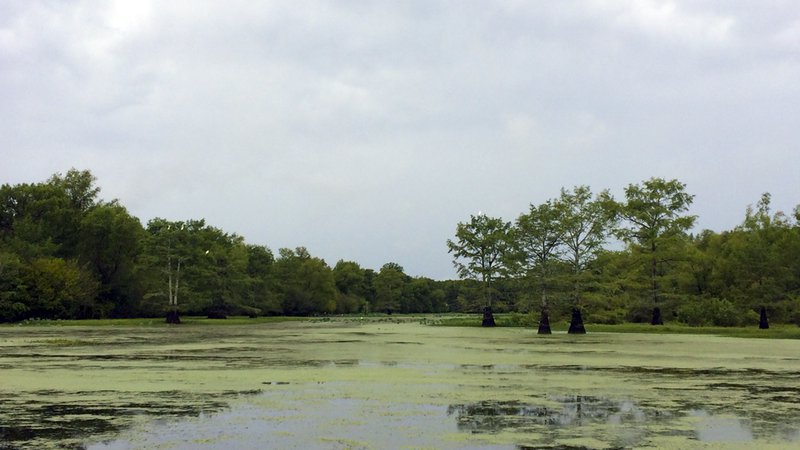Mercer Bayou renovation begins
ON 07-05-2017

July 5, 2017
Randy Zellers
Assistant Chief of Communications
Fisheries biologists with the Arkansas Game and Fish Commission opened up the upper gates at Mercer Bayou Tuesday as the first step in renovating this fertile fishery to increase angler access and sport fish populations. The bayou will be drained and remain as dry as possible for the next four years to reduce aquatic vegetation and sedimentation problems currently choking the system.
Fertility and aquatic vegetation often are seen as good things in the fisheries world, but too much of either can lead to failing fish populations and frustrated anglers.
“Hydrilla, coontail and fanwort took over the lake last year, but this year elodea has completely choked out the system,” said Eric Brinkman, regional fisheries supervisor at the AGFC’s Hope office. “It’s so thick that you can’t get through it without some kind of surface drive or mud motor, and we’ve even bogged that down crossing the bayou.”
The massive beds of vegetation not only block anglers from the fish, they have hindered sportfish reproduction by building a heavy layer of organic matter on the lakebed that suffocates their eggs.
“Fish kills also become more likely with this high concentration of vegetation,” Brinkman said. “The thick vegetation can reduce oxygen production in water, killing the fish.”
People normally think of aquatic vegetation as something that produces oxygen through photosynthesis, but it also uses oxygen to survive. During the night, when sunlight is not available, oxygen production stops and levels can crash to the point that they are too low for fish to survive.
Spraying the vegetation is an expensive option, and only a temporary fix. It also does not remedy the issue of the “muck” sitting at the bottom.
The plan, which was proposed to the Commission at its March meeting and shared with the public at two town hall meetings in April, is to dry things out and rebuild the fishery from ground up.
“Exposing all that vegetation and organic matter to the air and extreme temperatures will speed up the decaying process through aerobic decomposition and kill off the nuisance vegetation,” Brinkman said. “We plan to enhance that process by disking the lakebed and even doing some prescribed fires on the dried vegetation.”
Draining the lake also should reduce many of the unwanted fish currently inhabiting the lake. Silver carp, spotted gar and bowfin populations all have increased recently, competing for habitat with preferred sport fish, such as largemouth bass, crappie and bream.
In addition to the work done on the lakebed, biologists are planning a number of enhancements for the fishery and anglers.
“We’ll be removing stumps from the main channel and marking all the navigation channels while we have the opportunity,” Brinkman said. “We’ll also build catfish spawning structures to improve their reproduction in the bayou.”
The gates to the Bayou will be closed again at the end of four years, and the Bayou will be allowed to refill naturally. Channel catfish, forage fish and largemouth bass fingerlings will be stocked the following spring, and fingerling crappie will be stocked that fall.
It may be several years before the full effect of the renovation will be evident, but Brinkman says full and partial drawdowns done in other systems five to 10 years ago have created excellent results. Lower White Oak Lake and Lake Columbia both are seeing the delayed benefits of low water.
Brinkman says anglers still will be able to access the lake until the water level drops below the boat ramps, then the ramps will be closed until the refilling process begins in 2022. The temporary loss may mean anglers will need to find other bodies of water to explore, such as Millwood Lake, the Red River or Lake Erling, but the end result will be well worth the wait.
“It’s so choked with weeds right now, no one is even able to use it,” Brinkman said. “We haven’t seen a boat trailer at the ramp in a while.”
Recent News

AGFC Commissioner Meeting Notice
Jul. 15, 2025

Arkansas Wildlife Weekly Fishing Report
Jul. 10, 2025
Subscribe to Our Weekly Newsletter E-mails
Don’t miss another issue. Sign up now to receive the AGFC Wildlife Weekly Newsletter in your mailbox every Wednesday afternoon (Waterfowl Reports are published weekly during waterfowl season and periodically outside the season). Fishing Reports arrive on Thursdays. Fill in the following fields and hit submit. Thanks, and welcome!
